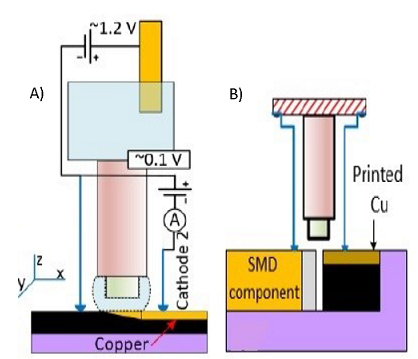Advantages
- 3D printing independent of type of substrate
- Improved hydrogen evolution assisted electroplating
- Both printing and soldering
- Low-cost and faster process
Summary
Our inventors have enhanced the 3D printing method for rapid and localized deposition of electrochemical metal on various substrates with low melting points. Currently, the hydrogen evolution assisted method is used to electroplate on materials with low melting points, and can be used for both printing and soldering metal tracks. The devised method improves upon the hydrogen evolution assisted method by printing metals at room temperature to solder electronic components to conductive tracks. This improved method can be used on materials such as 3D printed work pieces, flexible plastics, rubbers, and fabrics. This method is employed in a nozzle structure of a 3D printer to feature integration of electronic circuits in 3D designed structures. Our invention allows low-cost metal printing on conductive or non–conductive substrates. This technology can be widely used for the manufacturing of integrated circuits, PCBs, and electronic components.

A) Nozzle structure of 3D printer featuring integration of electronic circuits in 3D designed structures B) Surface mounted device for electrochemical soldering.
Desired Partnerships